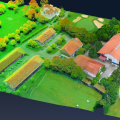A group of US scientists has discovered a way to distinguish polluting smoke from clouds. They have developed a multi-spectral approach using remote sensing measurements from NASA’s Moderate Resolution Imaging Spectro-radiometer. The scientists are based at George Mason University and NASA Goddard Space Flight Centre.
The researchers have identified smoke by filtering out other data based on differences in their spectral features. The team applies a scaled index to define the likelihood of smoke pixels and to characterise the smoke intensity.
Remote sensing is already in use to track and monitor smoke from space. However, most of the current implementations of the technique are unsuitable for bright surface areas, or in regions where smoke is mixed with clouds. Their process provides a rapid means of automatically localising the smoke in an entire MODIS swath.
The group plans to improve the algorithm by integrating multi-sensor measurements to detect biomass smoke more effectively and accurately.







